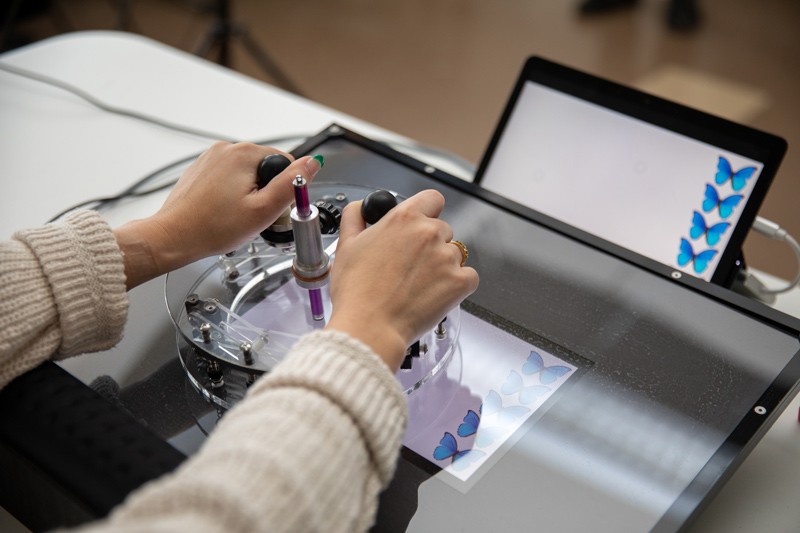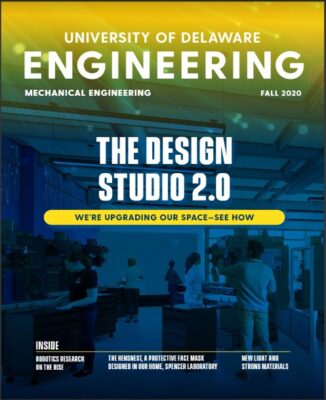Assistive drawing device developed through UD cross-college innovation aims to help people with disabilities
Artistic expression is a pivotal part of child development.
But many children with upper limb disabilities lack fine motor skills, inhibiting their ability to hold a pencil, paint or draw. Ashley Pigford is on a lifelong mission to improve the quality of life for people with disabilities by designing assistive technology that helps them live more independently.
The associate professor of art and design in the College of Arts and Sciences at the University of Delaware, has created innovative and affordable assistive eating and other mobility devices. Now, Pigford’s PushnDraw® is advancing to the next level through intensive and user-centered research. This next phase of development is possible because of a $50,000 grant from the donor-created Maggie E. Neumann Health Sciences Research Fund, which targets research and innovation that aims to improve the lives of people with disabilities.
Through crowdfunding support, Pigford began developing the assistive drawing device in 2018 to help children with arthrogryposis, a condition that causes joint contractures in upper and/or lower extremities. The spring-loaded device initially used a dry erase marker to allow kids to trace letter forms, navigate through mazes or draw to their heart’s content by relocating the act of drawing from the wrist and fingers into the shoulder and elbow. This afforded children with limited motor control the ability to write or draw independently. Adjustable springs can be custom-tailored to a child’s strength level, counteracting the weight of their hand.
“It’s about identifying the abilities of kids with disabilities and amplifying those to afford them more independence with activities of daily living,” Pigford said.

Ashley Pigford (far left), associate professor of art and design, leads a project — supported by the Maggie E. Neumann Health Sciences Research Fund — to advance his invention, the PushnDraw® assistive drawing device for children with upper limb disabilities. Pigford is working with Adam Wickenheiser (far right), associate professor of mechanical engineering, and mechanical engineering students Sara Dugan (second from left) and Logan Butler on this interdisciplinary research project.
The PushnDraw® has evolved from a strictly mechanical device into a system for human-computer interaction. The grant has allowed Pigford and the research team to significantly advance the mechanics of the device and take advantage of digital technology to create a more accessible device that incorporates computer programming and on-the-fly customization to accommodate varying levels of ability and feedback from parents and kids.
“A lot of parents said they wanted it to be more like a mouse for a computer,” Pigford said. “Kids with limited motor function need accessible ways to interact with digital systems, and we see potential for the PushnDraw® to both assist with occupational therapy and allow personal artistic expression. Incorporating a stylus, touchscreen and computer programming provides the opportunity for both activities.”
The grant was awarded to an interdisciplinary research team led by Pigford, who is co-director of UD’s Interaction Design Lab. The team includes Adam Wickenheiser, co-principal investigator and associate professor of mechanical engineering from the College of Engineering, and Michele Lobo, co-principal investigator and associate professor of physical therapy from the College of Health Sciences.
As a physical therapist, Lobo called it “rewarding” to work on a project that helps people participate in the activities they find fun and meaningful.
“Touchscreen devices have become common in our culture. They provide opportunities for people to be creative, to play games with friends, and to express themselves through drawing and writing,” Lobo said. “The device being designed in this project aims to ensure these opportunities are available to people with physical disabilities impacting their arms, people who otherwise cannot engage in these important social and expressive activities.”
Wickenheiser said engineering and art and design complement one another.
“Ashley brings aesthetic and quality of experience to the table whereas my expertise is on the underlying function of the device,” Wickenheiser said.
This interdisciplinary research project has allowed two mechanical engineering students to go beyond traditional engineering teachings and get outside their comfort zone.
“The user-experience, the aesthetics, the comfort and the desire to use and interact with an invention — that all goes beyond the fundamentals of what we teach in mechanical engineering,” Wickenheiser said. “This project pushes students beyond the core curriculum, so they can do independent research and design work.”
Logan Butler, an Honors sophomore mechanical engineering major, has always loved working with his hands and spending time with his father in their home woodshop. He even made the color-changing light bar in his dorm room.
“I grew up in a household where if something breaks, you try your best to fix it. That’s a rewarding feeling,” Butler said. “It’s nice to know I could buy it, but I could also make it myself and make it exactly the way I want it.”
When the opportunity to work on this project came his way, Butler couldn’t pass it up. He’s learned the value of trial and error and working in teams.
“In learning to be an engineer, I didn’t realize the full importance of design and aesthetics. I can design something that works, but Professor Pigford brings in the aesthetic to create a better overall user experience,” Butler said. “It opened my eyes to designing for the person who needs to use the device. This is why we work in teams because each person brings in a different experience.”
Wickenheiser said students often design projects, get a grade and move forward; they rarely get the opportunity to design for a client and receive feedback to enhance the design.
“I want them to generate ideas, and I want them to experience, at least, minor failures, so that they learn from those experiences,” Wickenheiser said. “I love the feedback where a student says: ‘I was afraid to try this or I hated doing this,’ and now they want to do this for their career. It’s like pushing a kid on training wheels — you get them going, and they go on their own power, and they’re so excited to go faster and learn more.”
Sara Dugan, a junior mechanical engineering major, wants to pursue a career in designing prosthetics. She was inspired by a former CrossFit workout buddy who was in a car crash and had a prosthetic leg. The opportunity to develop PushnDraw® has been a great way to hone her career path.
“I was so excited to build a product for a client from start to finish,” Dugan said. “It combines my interest in math and science, but also my passion for caring for others. It lines up with everything I want to do — design a medical device that helps people — that’s always been a dream.”
And that’s exactly the kind of mindset that Wickenheiser wants to see in his students.
“At one point it’s going to click with somebody, and you realize you’ve made a difference in a person’s life — and that’s what it’s all about,” Wickenheiser said. “I want Logan and Sara to be proud of what they’ve done, put their name on it, brag about it and take it to job interviews.”
The redesigned version of PushnDraw® is entering the testing phase, and the researchers are looking for families with kids with limited motor function in their hands, no specific diagnosis required, to sign-up and give the device a test-run.
Both Butler and Dugan are interested to see how kids react to the latest version of the device they helped craft.
“I really hope one of these kids will get this device and be able to express themselves in ways that they couldn’t before,” Butler said.
Feedback from this stage of their research will inform the final design.
“It’s insane to think that one day a kid could be using this, and maybe, they can participate in art class because they can now hold the paintbrush or hold the crayon,” Dugan said, “It’s cool to know that we could be changing the lives of kids who might be feeling left out or who haven’t found their interest or passion yet. I was lucky to find mine early on so if I could do something to help someone else find their passion that’d be awesome. I’m so invested to see where this goes.”
Pigford’s ultimate hope is that the device fuels artistic expression in kids.
“I hope PushnDraw® can serve in an art therapy context in a future phase,” Pigford said. “It comes down to just wanting to help and wanting to make life better for other people with the time that I have on this planet.”
About the Fund
Maggie E. Neumann Health Sciences Research Fund was established in 2020 to support research designed to improve health and quality of life outcomes for children and adults with physical and developmental disabilities. While the fund resides at the College of Health Sciences, the intent is to support interdisciplinary research across all UD colleges.
The research fund was created with a gift from Donald J. Puglisi and Marichu C. Valencia in honor of their granddaughter, Maggie E. Neumann. Puglisi is a member of UD’s Board of Trustees and they both serve on the President’s Leadership Council.
Article by Amy Cherry | Photos by Ashley Barnas | February 09, 2023


